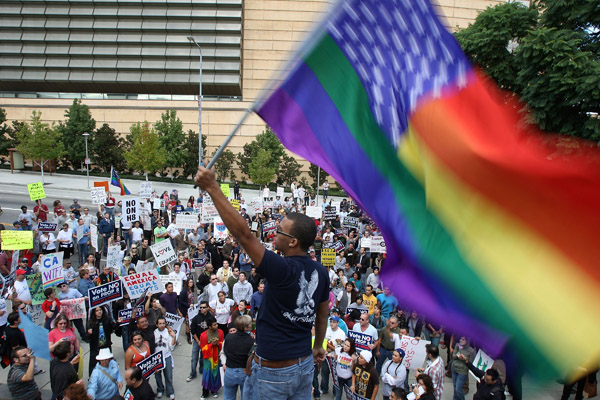3Qs: What’s next for gay rights in America?

 The Justice Department’s new policy to grant same-sex married couples equal protection in legal matters is the latest in a series of victories for gay rights advocates. We asked Libby Adler, a law professor with expertise in sexuality and gender identity, to explain the significance of the new guidelines and what the future of America’s gay rights movement will look like.
The Justice Department’s new policy to grant same-sex married couples equal protection in legal matters is the latest in a series of victories for gay rights advocates. We asked Libby Adler, a law professor with expertise in sexuality and gender identity, to explain the significance of the new guidelines and what the future of America’s gay rights movement will look like.
What kind of real-world implications will the Justice Department’s new policy have on same-sex married couples?
The Justice Department’s new policy is one of the logical consequences of the Supreme Court’s decision in June to strike down section 3 of the Defense of Marriage Act. That provision prohibited federal recognition of same-sex marriages that were valid in their states. The IRS is already treating married tax filers identically and the Social Security Administration is already treating applicants for survivor’s benefits identically. Given the Obama administration’s decision not to defend DOMA, it is hardly surprising to see Eric Holder’s Justice Department enthusiastically carrying out the implications of the decision in his corner of the government.
In real life terms, the new policy means that a number of instances of differential treatment will be remedied. For example, same-sex married couples in which one spouse is a federal prison inmate will have the same visitation and furlough privileges that different-sex married couples have; benefits programs administered by the Justice Department such as the September 11 Victims Compensation Fund will treat same-sex spouses the same as it treats different-sex spouses; and the Justice Department will urge that same-sex couples receive the same treatment and protections as different-sex spouses in bankruptcy proceedings.
The editorial board of The New York Times praised the Justice Department’s new policy, calling it a significant milestone in “advancing acceptance of same-sex relationships.” But it also characterized President Obama’s failure to sign an executive order prohibiting federal contractors from refusing to hire workers based on their sexual orientation as a “black mark on his record.” How would you assess President Obama’s overall gay rights record?
I do not find that charge useful in this situation. President Obama and Attorney General Holder have advanced the mainstream gay rights agenda more than anyone else in national politics—ever. Perhaps The New York Times has a checklist of “most important items for gay emancipation” that I do not have. In my view, President Obama is helping more LGBT people by advocating for an increase in the minimum wage than he would be by proliferating anti-discrimination protections. A recent study by the Williams Institute at UCLA showed that LGBT people are more likely than other Americans to be food insecure; President Obama can help LGBT people by focusing on restoring recently cut funding to the Supplemental Nutrition Assistance Program.
In a speech to a gay rights group in New York, Holder drew parallels between the 1950s civil rights movement and the current push to end discrimination against the LGBT community, saying, “My commitment to confronting discrimination based on sexual orientation or gender identity runs just as deep.” In 50 years, how will the gay rights movement be remembered by scholars, historians, and the general public?
I admire and appreciate Attorney General Holder’s commitment. The gay community and all Americans are fortunate to have someone with his sense of justice in his position.
I believe we will have same-sex marriage in every jurisdiction and wonder why it was ever a question; I also believe that we will have anti-discrimination protections in employment, public accommodations, and other contexts. The gay rights movement is on track to be remembered as a very successful movement for fairness and equality that captured the American mainstream.
A risk of this narrative is how much it leaves out. Surveys suggest that as much as 40 percent of the homeless youth in our cities are LGBT, and recent data suggest that LGBT adults are overrepresented among the homeless. Lesbian adolescents attract disproportionate attention of school disciplinarians and law enforcement, even when controlling for transgressive behavior. Transgender people are significantly overrepresented in prison, so wildly underemployed that anti-discrimination protections are barely of service when considered at the population level, and facing a radically reduced life expectancy. LGBT people, especially those with children, were more likely (even after controlling for race and education level) to depend on food assistance last year. When The New York Times praises the President but identifies as his one failing the absence of an executive order extending anti-discrimination coverage to federal contractors, it suggests to me that the Times does not really know how much there is to do. The call for equality gives the impression that discrimination is the only problem to be solved. Discrimination and bigotry are real problems, but for the success narrative of the gay rights movement to match the reality, the movement would need to make a real change in its priorities. It would have to shift attention to the distribution of income, nutrition, housing, health, and safety to our most marginalized community members.




